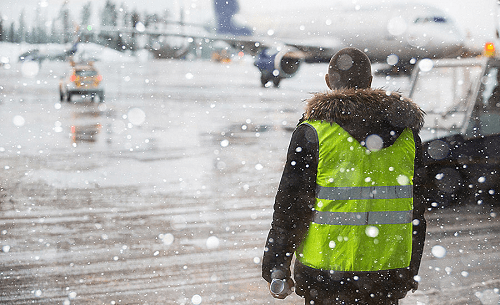
12.4.20 – ISHN
Employers have a responsibility to make sure their workers have access to warm, insulating winter gear when working outdoors in the winter or cold environments.
Staying safe on the job means staying warm when working in cold weather. Employers have a responsibility to make sure their workers have access to warm, insulating winter gear when working outdoors in the winter or cold environments. OSHA does not offer specific guidelines when it comes to keeping workers warm, but the agency requires employers to protect their workers from recognized hazards, which includes freezing temperatures, cold stress, hypothermia, and frostbite.
Finding the right fabric
There are many kinds of fabrics to choose from when selecting PPE for winter. Workers usually rely on six different materials when trying to stay warm on the job:
- Thermal: Sewn to create air pockets in different weaves and textures, thermal workwear traps heat and insulates against cold air. Some thermal fabrics can even include moisture-wicking properties.
- Fleece: Brushed for softness, extremely comfortable, and lightweight, fleece does a relatively good job at trapping in heat. On the flipside, it may not be as breathable if you’re active on the job.
- Pile: This fabric features brushed loops of material for staying warm. The loops, if made of cotton, can act like tiny sponges and absorb water, just like a Terrycloth towel.
- Foam: A lightweight material that adds insulation in between layers.
- Wool: Naturally thick with insulation, wool dries quickly, so it’s good to use in wet applications. However, it isn’t a commonly used material for PPE. Some workers may have an allergy to this material or may find it itchy if used as a base layer.
- Acrylic: Features stringy material for preserving body heat.
Layering PPE
It’s best to layer different fabrics on top of each other when working in frigid temperatures. Provide a variety of sizes for your team to choose from. Some workers may need larger sizes when wearing multiple layers at the same time. Every layer serves a different purpose.
Keep the wicking layer closest to the skin. This includes synthetic or wool materials that keep moisture off the body. Stay away from cotton as it absorbs moisture. Use a thin insulating layer to cover the wicking layer. Thermals and acrylics tend to be a great choice.
Surround this with a thick layer of clothing to lock in body heat, such as wool, cotton, or fleece.
The last layer should be the winter coat, ideally waterproof. It should come with some ventilation to prevent overheating while allowing moisture and perspiration to pass through.
Gloves for slick situations
Your team won’t get far on the job without the proper gloves. Our hands tend to be extremely vulnerable to freezing temperatures, which can lead to a loss of feeling, hypothermia, or poor circulation, limiting their range of movement on the job.
That’s why it’s best to invest in waterproof, insulated gloves that are specifically designed for field workers. These go above and beyond the gloves you’d find at your local department store. They are made with insulating materials to keep the person’s hands warm without limiting their range of movement.
The fingers come with a textured, rigid surface for working in slippery situations, so workers can still use various tools on the job. This is the ideal choice for those in the oil and gas industry. It’s also best to make sure the gloves are touchscreen compatible, so they can still use their phone or tablet on the job. Even insulated gloves may not be enough to keep the cold at bay. Look for gloves that come with a small inner pouch, so you can insert additional hand warmers throughout the day.
Improving visibility
Seeing workers can be a challenge in winter conditions. From falling snow to hazy skies and fog, it’s best to invest in bright, neon winter clothing, preferably ANSI-certified, that improves visibility. Look for coats, vests, and jackets that come with reflective tape for capturing the light.
Sunglasses and eye protection
Working in the snow can be blinding, so use UV-coated sunglasses or eyewear to limit the glare. This will protect the person’s eyes while giving them a clear view of their surroundings.
Additional safety practices
Be aware of the risks when working outside. Monitor the temperature and keep additional layers on hand in case one of your workers starts to feel the chill. Teach everyone to watch out for warning signs of frostbite, hypothermia, and cold stress. Use the buddy system to make sure everyone is staying safe in the field. Staying safe in extreme temperatures is often a group effort.
